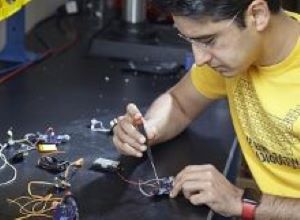A new ultra-affordable and accessible hearing aid made from open-source electronics and meeting WHO standards has been developed at the Georgia Institute of Technology.
Hearing aids are a major tool for individuals with hearing loss – especially age-related hearing loss, which currently affects approximately 226m adults over the age of 65 worldwide (and is projected to affect 900m by 2050). However, hearing aid adoption remains relatively low among adults: fewer than 3% of adults in low-and-middle-income countries (LMIC) use hearing aids, versus around 20 percent of adults in non-LMIC countries.
Though various reasons contribute to this poor uptake, cost is a significant factor. While the price to manufacture hearing aids has decreased over time, the retail price for a pair of hearing aids ranges from $1,000 to $8,000, with the average pair costing $4,700 in the US.
In this study, Soham Sinha from the Georgia Institute of Technology, and colleagues used mass-produced open source electronics to engineer a durable, affordable, self-serviceable hearing aid that meets most of the targets set by the World Health Organisation (WHO) for mild-to-moderate age-related hearing loss: LoCHAid. When mass-produced at 10,000 units including earphones, a coin-cell battery, and holder, LoCHAid costs $0.98 (this doesn’t include labour costs) and is designed to be marketed over-the-counter – or even as a DIY project.
LoCHAid doesn’t require specialty parts, and repairs can be completed by a minimally skilled user with access to a soldering iron and solder. Though it’s not currently programmable, simulations show that the LoCHAid is well fitted to a range of age-related hearing loss profiles for men and women between the ages of 60-79 years.
Potential limitations include the device lifetime (currently 1.5 years), as well as its relatively large size, which may not appeal to all consumers. The authors are currently working on a smaller prototype, but this costs more money to produce and would likely require third-party assemblers.
Despite these limitations, LoCHAid shows great potential to benefit individuals impacted by age-related hearing loss, especially those consumers challenged by the affordability and accessibility of current hearing aids available on the market.
The authors add: “In this work, we describe the development and rigorous audiological testing a minimal, 3d-printed and ultra low-cost ($1 in parts) hearing aid. The vision of the device is to make hearing aid accessible and affordable for elderly individuals with age related hearing loss in low- and middle-income countries.”
Abstract
Hearing aids are the primary tool in non-medical rehabilitation for individuals with hearing loss. While the costs of the electronic components have reduced substantially, the cost of a hearing aid has risen steadily to the point that it has become unaffordable for the majority of the population with Age-Related Hearing Loss (ARHL) especially for those residing in low- and middle-income countries. Here, we present an ultra-low-cost, affordable and accessible hearing aid device (‘LoCHAid’), specifically targeted towards treating ARHL in elderly patients. The LoCHAid components cost 98 cents (< $1) when purchased in bulk for 10,000 units and can be personalized for each user through a 3D-printable case. It is designed to be an over-the-counter (OTC) self-serviceable solution for elderly individuals with ARHL. Electroacoustic measurements show that the device meets most of the targets set out by the WHO Preferred Product Profile and Consumer Technology Association for hearing aids. The frequency response of the hearing aid shows selectable gain in the range of 4-8 kHz, and mild to moderate gain between 200-1000 Hz, and shows very limited total distortion (1%). Simulated gain measurements show that the LoCHAid is well fitted to a range of ARHL profiles for males and females between the ages of 60-79 years. Overall, the measurements show that the device offers the potential to benefit individuals with ARHL. Thus, our proposed design has the potential to address the challenge of affordable and accessible hearing technology for hearing impaired elderly individuals especially in low- and middle-income countries.
Authors
Soham Sinha, Urvaksh D Irani, Vinaya Manchaiah, M Saad Bhamla
[link url="https://journals.plos.org/plosone/article?id=10.1371/journal.pone.0238922"]PLOS ONE abstract[/link]

